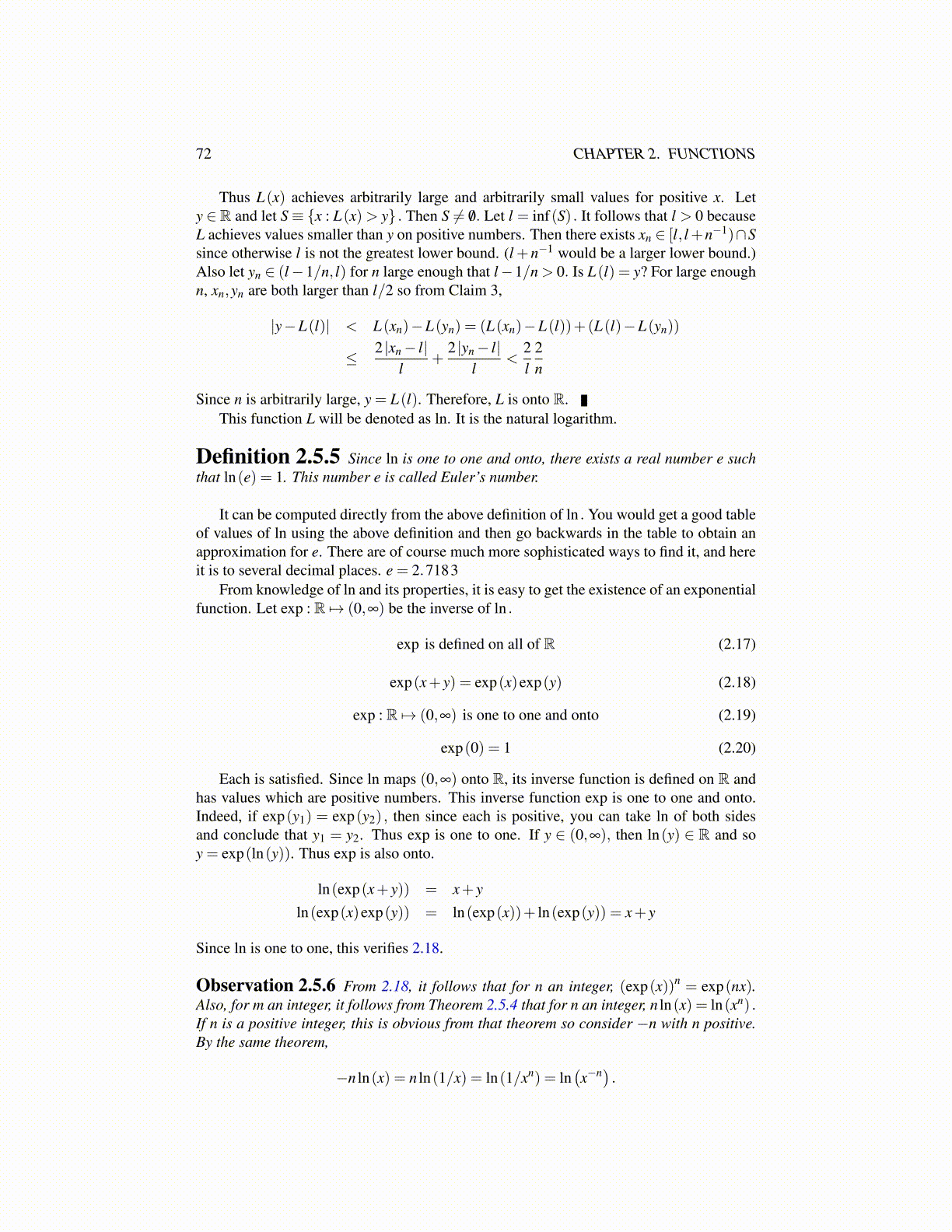
72 CHAPTER 2. FUNCTIONS
Thus L(x) achieves arbitrarily large and arbitrarily small values for positive x. Lety ∈ R and let S ≡ {x : L(x)> y} . Then S ̸= /0. Let l = inf(S) . It follows that l > 0 becauseL achieves values smaller than y on positive numbers. Then there exists xn ∈ [l, l+n−1)∩Ssince otherwise l is not the greatest lower bound. (l +n−1 would be a larger lower bound.)Also let yn ∈ (l −1/n, l) for n large enough that l−1/n > 0. Is L(l) = y? For large enoughn, xn,yn are both larger than l/2 so from Claim 3,
|y−L(l)| < L(xn)−L(yn) = (L(xn)−L(l))+(L(l)−L(yn))
≤ 2 |xn − l|l
+2 |yn − l|
l<
2l
2n
Since n is arbitrarily large, y = L(l). Therefore, L is onto R.This function L will be denoted as ln. It is the natural logarithm.
Definition 2.5.5 Since ln is one to one and onto, there exists a real number e suchthat ln(e) = 1. This number e is called Euler’s number.
It can be computed directly from the above definition of ln . You would get a good tableof values of ln using the above definition and then go backwards in the table to obtain anapproximation for e. There are of course much more sophisticated ways to find it, and hereit is to several decimal places. e = 2.7183
From knowledge of ln and its properties, it is easy to get the existence of an exponentialfunction. Let exp : R 7→ (0,∞) be the inverse of ln .
exp is defined on all of R (2.17)
exp(x+ y) = exp(x)exp(y) (2.18)
exp : R 7→ (0,∞) is one to one and onto (2.19)
exp(0) = 1 (2.20)
Each is satisfied. Since ln maps (0,∞) onto R, its inverse function is defined on R andhas values which are positive numbers. This inverse function exp is one to one and onto.Indeed, if exp(y1) = exp(y2) , then since each is positive, you can take ln of both sidesand conclude that y1 = y2. Thus exp is one to one. If y ∈ (0,∞), then ln(y) ∈ R and soy = exp(ln(y)). Thus exp is also onto.
ln(exp(x+ y)) = x+ y
ln(exp(x)exp(y)) = ln(exp(x))+ ln(exp(y)) = x+ y
Since ln is one to one, this verifies 2.18.
Observation 2.5.6 From 2.18, it follows that for n an integer, (exp(x))n = exp(nx).Also, for m an integer, it follows from Theorem 2.5.4 that for n an integer, n ln(x) = ln(xn) .If n is a positive integer, this is obvious from that theorem so consider −n with n positive.By the same theorem,
−n ln(x) = n ln(1/x) = ln(1/xn) = ln(x−n) .